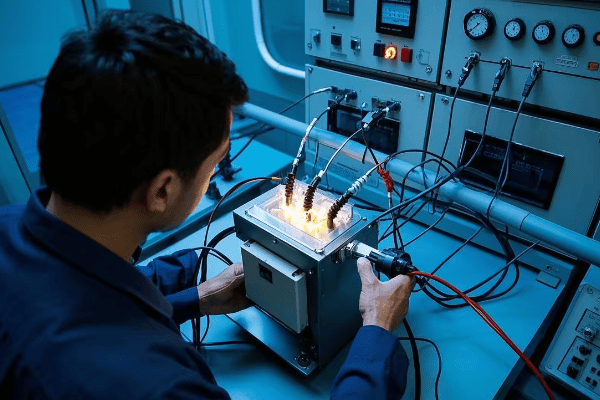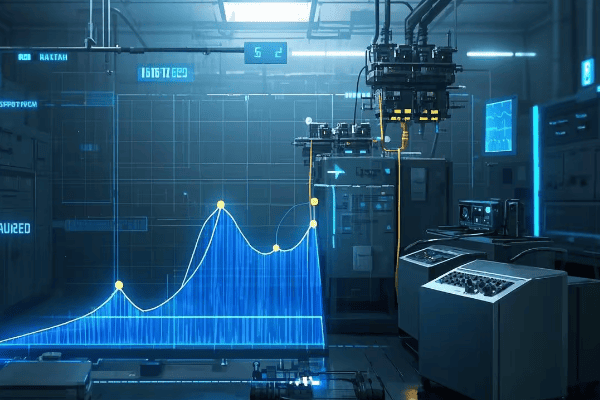What is Transformer Impedance: The Key to Power System Stability?
Are you struggling to understand transformer impedance? You’re not alone. Many engineers find this concept challenging, but it’s crucial for power system design.
Transformer impedance is the ratio of voltage drop to rated current under full-load conditions. It combines winding resistance and leakage reactance, typically ranging from 4% to 12%. This parameter is vital for fault current limitation, voltage regulation, and overall system stability.

As an electrical engineer with years of experience in transformer design, I’ve seen firsthand how critical impedance is to power system performance. Let’s dive into the world of transformer impedance and uncover its secrets.
How is Transformer Impedance Defined and Measured?
Have you ever wondered why some transformers perform differently under load? The answer often lies in their impedance. But how do we define and measure this crucial parameter?
Transformer impedance is defined as the percentage voltage drop across the transformer at full load current. It’s measured through short-circuit tests, where the secondary winding is shorted, and voltage is applied to the primary until rated current flows.

Throughout my career, I’ve conducted numerous impedance tests on transformers. Let’s break down the process and understand what these measurements tell us:
Definition of Transformer Impedance
-
Percentage Impedance
- Expressed as a percentage of rated voltage
- Typically ranges from 4% to 12% for distribution transformers
- Higher values (up to 20%) for large power transformers
-
Components of Impedance
- Resistance (R): Due to copper losses in windings
- Reactance (X): Due to leakage flux
-
Impedance Triangle
- Z (total impedance) = √(R² + X²)
- Usually, X is much larger than R
Measurement Process
-
Short-Circuit Test
- Secondary winding is short-circuited
- Voltage applied to primary winding
- Increase voltage until rated current flows
-
Calculations
- Impedance Voltage (Vz) = Applied voltage at rated current
- Percentage Impedance = (Vz / Rated Voltage) × 100
-
Separating R and X
- Measure power input (W) during the test
- R = W / I² (where I is rated current)
- X = √(Z² – R²)
| Parameter | Typical Value | Significance |
|---|---|---|
| % Impedance | 4% – 12% | Higher values limit fault currents more |
| R/X Ratio | 0.1 – 0.5 | Lower ratios indicate more reactive impedance |
| Temperature | 75°C | Standard reference temperature for measurements |
I remember a project where we were troubleshooting a transformer with unexpectedly high losses. Through careful impedance measurements, we discovered that the actual impedance was 15% instead of the specified 10%. This finding led us to identify a manufacturing defect in the core, potentially saving the client from a costly failure.
Factors Affecting Impedance
-
Winding Design
- Number of turns
- Conductor size and material
- Winding geometry (concentric vs. pancake)
-
Core Design
- Core material (grain-oriented silicon steel vs. amorphous metal)
- Core geometry (shell-type vs. core-type)
-
Insulation
- Type and thickness of insulation materials
- Affects leakage flux paths
-
Tap Changers
- Can alter effective turns ratio
- May change impedance slightly
Understanding how transformer impedance is defined and measured is crucial for engineers working with power systems. It’s not just a number on a specification sheet; it’s a key parameter that affects everything from fault current levels to voltage regulation. By mastering the concepts behind impedance, we can design more efficient and reliable power distribution systems.
Why is Transformer Impedance Crucial for Power System Stability?
Ever wondered why some power systems are more stable than others? The secret often lies in the careful selection of transformer impedance. But why is this parameter so important?
Transformer impedance plays a vital role in power system stability by limiting fault currents, influencing voltage regulation, and affecting system losses. It acts as a buffer against disturbances and helps maintain consistent power quality across the network.

In my years of designing and optimizing power systems, I’ve seen the profound impact that transformer impedance can have. Let’s explore why this parameter is so crucial:
Impact on Fault Current Limitation
-
Short Circuit Current Reduction
- Higher impedance limits fault current magnitude
- Protects equipment from excessive thermal and mechanical stress
-
Coordination of Protective Devices
- Helps in proper sizing and setting of circuit breakers and fuses
- Ensures selective tripping during faults
-
System Reliability
- Reduces likelihood of widespread outages during faults
- Minimizes damage to equipment, extending lifespan
Influence on Voltage Regulation
-
Voltage Drop Under Load
- Higher impedance leads to greater voltage drop
- Affects power quality at the point of use
-
Tap Changer Operation
- Impedance affects the range and frequency of tap changes
- Impacts the life of tap changing mechanisms
-
Parallel Operation
- Impedance matching is crucial for load sharing between transformers
Effect on System Losses
-
Load Losses
- Higher impedance generally means higher copper losses
- Impacts overall system efficiency
-
No-Load Losses
- Core design affects impedance and no-load losses
- Trade-off between impedance and efficiency
| Aspect | Low Impedance | High Impedance |
|---|---|---|
| Fault Current | Higher | Lower |
| Voltage Regulation | Better | Poorer |
| System Losses | Generally Lower | Generally Higher |
| Cost | Higher (due to higher fault ratings) | Lower |
I once worked on a project upgrading a industrial power system. We initially considered low impedance transformers for better voltage regulation. However, after analyzing the potential fault currents, we opted for higher impedance units. This decision not only reduced the required fault ratings of downstream equipment but also improved the overall system stability during voltage sags.
Case Study: Urban Substation Upgrade
In a recent project, we upgraded a urban substation serving a mix of residential and commercial loads. Here’s how transformer impedance played a crucial role:
-
Initial Situation
- Frequent voltage fluctuations
- High fault currents causing nuisance tripping
-
Solution
- Replaced 5% impedance transformers with 7.5% units
- Implemented advanced tap changers
-
Results
- 30% reduction in fault current levels
- Improved voltage stability (±2.5% vs previous ±5%)
- 50% reduction in protective device operations
This case demonstrates how carefully selected transformer impedance can significantly improve system performance and reliability.
Considerations for Different Applications
-
Distribution Systems
- Typically use higher impedance (5-8%)
- Focus on fault current limitation and voltage drop balance
-
Industrial Systems
- Often require lower impedance (4-5.5%)
- Emphasis on voltage regulation for sensitive equipment
-
Renewable Energy Integration
- May need specialized impedance values
- Must consider bi-directional power flow
-
Data Centers
- Very low impedance transformers (3-4%)
- Critical for maintaining stable voltage for IT equipment
Understanding the role of transformer impedance in power system stability is crucial for electrical engineers and system designers. It’s not just about selecting a number; it’s about balancing multiple factors to achieve optimal system performance. By carefully considering impedance in our designs, we can create more resilient, efficient, and reliable power systems that meet the evolving needs of our increasingly electrified world.
How Does Transformer Impedance Affect Fault Current and Protection Coordination?
Worried about the safety and reliability of your power system? Understanding how transformer impedance affects fault currents and protection coordination is key to addressing these concerns.
Transformer impedance directly influences fault current levels and plays a crucial role in protection coordination. Higher impedance reduces fault currents, affecting the selection and settings of protective devices. It’s essential for ensuring selective tripping and preventing widespread outages.

Throughout my career, I’ve dealt with numerous power system protection challenges. Let’s dive into how transformer impedance impacts fault currents and protection coordination:
Impact on Fault Current Levels
-
Inverse Relationship
- Higher impedance results in lower fault currents
- Fault Current = System Voltage / Total Impedance
-
Typical Fault Current Ranges
- Low impedance (4%): Up to 25 times rated current
- High impedance (8%): Up to 12.5 times rated current
-
System Benefits
- Reduced stress on equipment during faults
- Lower required interrupting ratings for circuit breakers
Protection Coordination Considerations
-
Overcurrent Protection
- Higher impedance allows for lower pickup settings
- Improves sensitivity to distant faults
-
Differential Protection
- Impedance affects the slope characteristic
- Higher impedance may require adjusted settings
-
Distance Protection
- Impacts the reach of distance relays
- May require zone adjustments based on impedance
| Impedance | Typical Fault Current | Protection Implications |
|---|---|---|
| 4% | 25x rated | Higher interrupting ratings needed |
| 6% | 16.7x rated | Balanced protection and equipment cost |
| 8% | 12.5x rated | Improved protection sensitivity |
I recall a project where we were upgrading a distribution substation. The existing 4% impedance transformers were causing nuisance tripping of downstream breakers during minor faults. By replacing them with 7% impedance units, we significantly improved the coordination of protective devices and reduced unnecessary outages.
Case Study: Industrial Plant Protection Upgrade
Let’s look at a real-world example of how transformer impedance affected protection coordination in an industrial setting:
-
Initial Situation
- 20MVA, 4% impedance transformer
- Frequent trips on minor faults
- Difficulty distinguishing between normal inrush and fault currents
-
Analysis
- Fault current levels exceeding downstream breaker ratings
- Poor coordination between transformer and feeder protection
-
Solution
- Replaced with 7% impedance transformer
- Adjusted relay settings across the system
-
Results
- 40% reduction in fault current levels
- Improved discrimination between inrush and fault currents
- 70% reduction in nuisance tripping incidents
Key Considerations for Protection Engineers
-
Fault Current Calculations
- Always consider transformer impedance in fault studies
- Use software tools for complex system analysis
-
Protective Device Selection
- Choose devices with appropriate interrupting ratings
- Consider future system growth and potential impedance changes
-
Coordination Studies
- Perform detailed time-current curve analysis
- Ensure proper coordination between upstream and downstream devices
-
Special Applications
- Generator step-up transformers may require different approaches
- Renewable energy systems need careful consideration of bi-directional flows
-
System Stability
- Higher impedance can improve transient stability during faults
- May require additional studies for critical systems
Understanding the relationship between transformer impedance, fault currents, and protection coordination is crucial for designing safe and reliable power systems. It’s not just about preventing equipment damage; it’s about ensuring continuity of service and protecting human life. By carefully selecting transformer impedance and coordinating protection systems accordingly, we can create more resilient and responsive power networks.
Conclusion
Transformer impedance is a critical parameter that significantly impacts power system stability, fault current levels, and protection coordination. By understanding and carefully selecting appropriate impedance values, engineers can design safer, more reliable, and efficient power distribution systems that meet the evolving needs of modern electrical infrastructure.
Free CHBEB Transformer Catalog Download
Get the full range of CHBEB transformers in one catalog.
Includes oil-immersed, dry-type, pad-mounted, and custom solutions.
Quick Message
Request A free quote
We'd like to work with you
- +86 15558785111
- [email protected]
- +86 15558785111
What We Do
CHINA BEI ER BIAN (CHBEB) GROUP, with 218 million in registered capital, originated from Beijing Beierbian Transformer Group. Headquartered in Beijing for R&D, it operates major production bases in Nanjing and Yueqing, producing high-quality products.
Latest Product
address
BeiJing
No 3,RongJing East Road,BeiJing Economic Technological Development Area,BeiJing,China
JiangSu
No 7️Xiangfeng Road,Jiangning,NanJing,JiangSu,China
WenZhou
No.211, Wei 16 Road, Industrial Zone, Yueqing, Wenzhou, Zhejiang, China.
XiangYang Industrial Zone ,YueQing,WenZhou,ZheJiang,China
contact us
- [email protected]
- +86 13057780111
- +86 13057780111
- +86 15558785111
Copyright © Bei Er Bian Group


